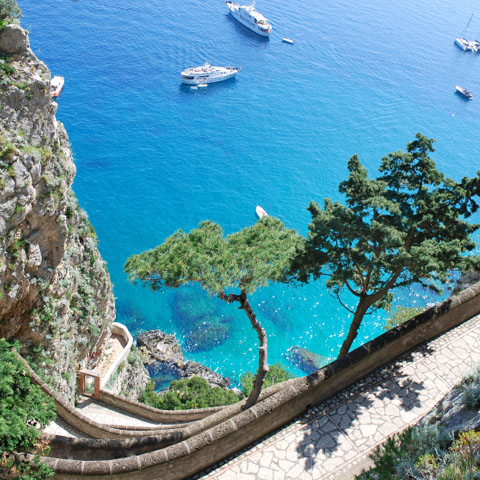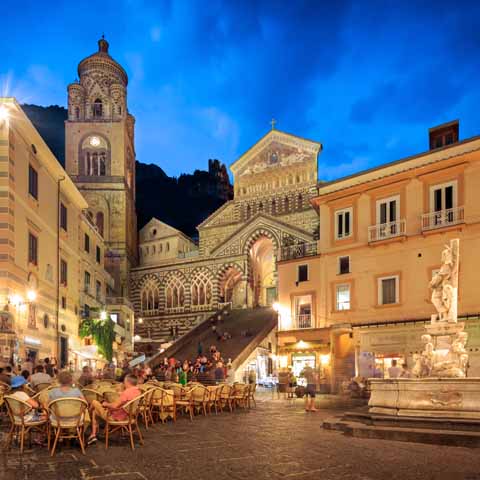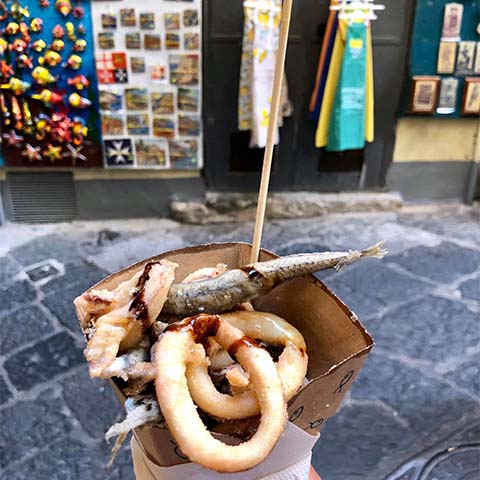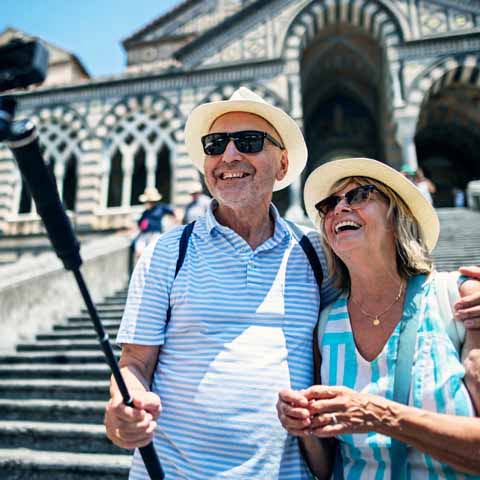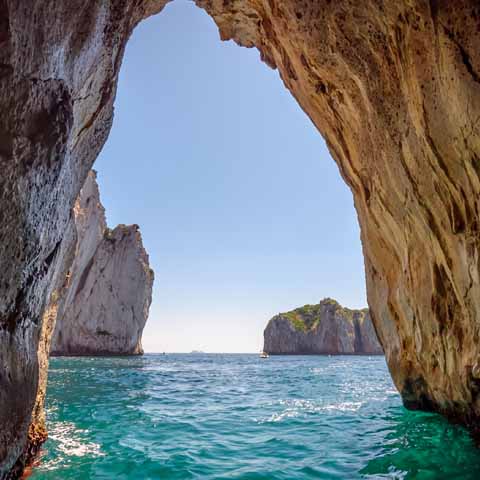Campania – Things to Do
Campania is an amazing place that offers a myriad of things to do, including natural and manmade monuments to see and explore. The gentleness of the climate, the beauty of the coast and the richness of the art and history make Campania a favorite vacation spot when planning a trip to Italy.
In Campania, the word boredom doesn’t exist. There is always something new to discover in this land kissed by the sun and caressed by the sea. The crystalline waters of the Tyrrhenian Sea seem to embrace the cities and villages of Campania, creating breathtaking bays which become even more impressive when admired from the paradisiac islands of the Gulf.
Vesuvius, on the other hand, is overlooking Naples, the capital of the region, a city animated by a peculiar lifestyle, a perfect blend of folklore, traditions, and spirituality.
But Campania is not just Naples and its surroundings. The whole region has a story to tell and places like Paestum, Herculaneum, Pompeii, or Caserta will take you back in time to long-forgotten ages.
Festivals & Events
Campania is a marvelous land characterized by a mild and dry climate and an enchanting landscape composed of hills and valleys, green mountains, cultivated terraces, steep cliffs and a crystalline sea. Besides the idyllic landscape, Campania is also defined by its ancient traditions, a rich cultural heritage, and a vast artistic patrimony.
In this territory, numerous festivals and events are held each year, such as patron saint festivals, carnivals, and spiritual processions with secular origins. Most of the festivals take place in summer or autumn and promote the delicious local products, while the Christmas season is renowned for its festivities that are unique not only in Italy, but in the world.
Probably the most important traditional festival to mention is the Feast of San Gennaro which takes place on September 19 in Naples. A celebration of the city’s patron saint, the Feast of San Gennaro centers around the miracle of the liquefication of San Gennaro’s blood. This miracle is said to occur at least three times each year on the Saturday that precedes the first Sunday of May, on September 19, and on December 16. As the protector of Naples, the liquefication of San Gennaro’s blood is considered to be a good omen for the city.
Another important festival, celebrated on June 22 (only if that day is a Sunday, if not it is planned for the first Sunday after June 22) is the Festa dei Gigli in Nola. The festival commemorates the return of Bishop San Paolino after he was held in captivity in northern Africa during the 5th century. To celebrate this day, locals build eight wooden obelisks that are carried by more than 100 men in a solemn procession. Additionally, a statue of the saint is placed on a boat-shaped pedestal, and songs and dances are performed around it. Without a doubt, this is one of the most interesting folkloristic events to attend in the region.
The Festival of Sant’Anna in Ischia is another important Catholic event that transformed over the years. The festival is held each year on July 26, and what attracts locals and tourists alike is a parade held on the shores of the sea, in front of the rocks of Ischia Ponte. When the parade is over, the famous Palio di Sant’Anna occurs, which is a race between the towns of the island plus Capri and Procida. After the race, everyone gathers at the foot of the Aragonese Castle to admire a mesmerizing fireworks show that reenacts the historic burning of the castle by the Saracens.
Among the patron saint festivals in Campania, one of the most characteristic is the festival of the Madonna delle Galline, held in Pagani, in the province of Salerno. This folkloristic event is a triumph of dances, traditional music, and colorful costumes. Hens are the protagonists of this event, as it is believed that some hens found a precious wooden icon of Virgin Mary while fluttering in the fields. The icon, dating from the 16th century, was placed inside a church and, according to tradition, it soon began to perform miracles. In the 17th century, the locals built a sanctuary dedicated to the Madonna delle Galline and the holy image has been celebrated ever since. The festival is held each year on the Friday after Easter until the following Monday. The Virgin is carried through the streets of Pagani and locals accompany it while playing the characteristic tammurriate, regional musical instruments similar to tambourines. The faithful offer doves, chickens and peacocks to the Virgin Mary as a sign of devotion, while enjoying traditional dances.
The devotion to the Madonna is very much felt in other places in Campania as well, especially in the town of Torre Annunziata where the patron saint is the Madonna della Neve. The recurrence of this festival falls on August 5, commemorating an event from the 14th century when fishermen found a chest containing a terracotta statue of the Virgin with Child. The sacred statue, venerated by the people, is the protagonist of a miracle that took place in the 19th century when the holy object protected the town from the lava and ash of Vesuvius. Nowadays, the devoted locals take the statue and carry it through the streets of the town, then a fisherman’s boat reenacts the prodigious finding of the statue and the miracle of the lava.
Throughout Campania and especially in the metropolitan area of Naples, the year-end festivities have a unique and remarkable importance. There are many traditions linked to this time of the year, but probably the most impressive is the Presepe (Nativity Scene) that finds its maximum expression and representation on Via San Gregorio Armeno, a narrow and lively street in Naples. This place is full of unique wonders produced by local artisans. Besides the many statues and objects designed to animate the nativity scene, the municipality also organizes Presepi Viventi, living nativity scenes that have a great emotional impact.
A fun and entertaining event to attend is Palio della Botte in Avellino, held during the month of August. This medieval reenactment involves a race between the seven districts of the city, and the participants have to roll a heavy barrel uphill that weighs about two quintals (or close to 440 pounds). The team who reaches the Fountain of Bellerofonte first wins the race.
Also in the province of Avellino there are unique Carnival traditions with celebrations that feature Zeza, the wife of Pulcinella, a classical character of the commedia dell’arte that is tied to Naples.
Outdoor Activities
Campania is synonymous with numerous outdoor activities that satisfy the demands of those who love uncontaminated nature and unique settlements.
Without a doubt, yachting and boating represent some of the most attractive outdoor activities. From simply admiring the coast to visiting the region’s famous islands such as Capri and Ischia, the choices are endless.
Sail to Capri and discover its many fascinating sites including the Gardens of Augustus and the remarkable Blue Grotto, a sea cave famous for its mesmerizing blue light. Active travelers will enjoy exploring the hiking paths on the upper part of the island, called Anacapri. There is even a panoramic chairlift that offers remarkable views of the island and sea from above.
Spending a day in Ischia allows travelers to uncover the history of this unique island as well as unwind at one of the renowned thermal spas.
Apart from sailing, diving and snorkeling are two other attractive outdoor activities to enjoy in Campania.
The Cape of Palinuro is one of the most popular diving areas in Campania, a place where you can dive up to 131 feet deep. One of the most notable attractions is the Blue Grotto, renowned for the intense blue color of its water, which is reminiscent of the more famous Blue Grotto on the island of Capri.
Secca delle Formiche, located between Procida and Ischia, is another amazing diving spot. This reef has an enormous biological interest due to its biodiversity, but also because of its peculiar formation; in fact, it is a submerged natural arch through which the rays of the sun penetrate the depths of the sea, creating fantastic light effects.
To discover a sort of “Atlantis,” the submerged city of Baia, located only half an hour from Naples, is a diving place that will certainly conquer enthusiasts with its breathtaking beauty. The city was an important Roman center and today you can admire the opulent lifestyle of the Romans preserved under the crystalline waters of the sea.
Diving or sailing are only part of the many outdoor activities in Campania. Thanks to the rich and diverse territory, the region offers numerous trails and paths to lovers of hiking. One of the most iconic paths is, without a doubt, Sentiero degli Dei that encompasses most of the Amalfi Coast along the Lattari Mountains. Considered one of the most beautiful hiking paths in the world, the trail passes through numerous characteristic villages and offers breathtaking sceneries of natural beauty.
To admire wild beaches, hidden bays, and a crystal-clear sea, but also many important archaeological sites, Cilento is an area to consider when in Campania. The southernmost part of the coast and at the border with Basilicata, Cilento is one of the most interesting places in the region.
The territory includes the Cilento National Park where the splendor of Greece meets the sophistication of the Bourbon dominion in the small villages located throughout the territory.
Last but not least, a hike on Mount Vesuvius offers a unique and unparalleled experience in Campania. The slopes of the volcano hold interesting trails from a naturalistic point of view, while the heritage of the long-gone civilizations awaits in the archeological ruins of settlements such as Pompeii and Herculaneum.
Indoor Activities
From the capital of the region to almost forgotten treasures hidden in small towns and villages, Campania is full of interesting attractions and indoor activities that can satisfy all tastes.
Among all the indoor attractions in Campania, the first that comes to mind is the Duomo of Naples, a spiritual place dedicated to San Gennaro, the patron saint of the city and of the region. Rich in decorated chapels and embellished by Luca Giordano’s paintings depicting the Apostles, the Duomo is the first and foremost place where Neapolitans go to worship their Holy Patron.
The statue of the veiled Christ, located in the Chapel of San Severo, is another important artwork to admire. The statue is one of the most fascinating and mysterious works that can be seen in Naples. Due to the remarkable perfection of the marble veil that lays on Christ’s body, according to a legend, it is believed that the veil itself was originally made of fabric before being turned into rock thanks to a special liquid invented by the Prince of San Severo, an illustrious alchemist and patron of the chapel. The chapel, literally a gem hidden among the alleys of Naples, is worth seeing even beyond the veiled Christ as it is full of fascinating esoteric and religious symbols.
In Naples, two alternative places to visit are some of the artistically decorated subway stops and also Naples Underground, a series of ruins and archaeological findings buried underneath the modern city.
There are also countless museums to visit in Naples, such as the National Archeological Museum and the Royal Palace of Naples.
Close to Campania’s capital, an important site to discover is the Reggia di Caserta, one of the most important monuments of the Italian artistic heritage and also a UNESCO World Heritage site. The royal palace was designed by architect Luigi Vanvitelli in the 18th century on the orders of Charles III of Bourbon. The result is an architectural masterpiece that boasts impressive decorations and many important works of art such as bas-reliefs, frescoes, sculptures and inlaid floors. If the weather is good, the wonderful park outside the palace is a must for discovering an impressive example of an Italian garden structured with meadows, flowerbeds, ponds and fountains. Next to it, a beautiful English garden is a true heaven for lovers of nature boasting a rich collection of indigenous and exotic plants.
Apart from these iconic landmarks of the region, throughout Campania, there are many other sites to see, such as the Aragonese Castle in Ischia, Villa Rufolo in Ravello, the Duomo of Amalfi, and other attractions.
Shopping in Campania
Whether you are looking for authentic souvenirs, designer bargains or unique local fashions, Campania is a great place for the shopping enthusiast.
In terms of fashion, and more precisely in terms of beach and summer fashion, Positano is the place to discover. The town is renowned all over the world for its unique garments and here it is easy to find splendid dresses, sandals, and other fashion accessories.
If you are looking for something authentic, Via San Gregorio Armeno in Naples is the place to go. Along this narrow and crowded street, there are many artisan shops that sell statues and items related to Naples’ nativity scene tradition.
Vietri sul Mare is the place to find unique ceramic objects that are famous all over the world for their beauty and quality.
Sorrento and the surrounding area represent the perfect place to find local goodies. A symbol of the area is Limoncello, a liqueur famous all over Italy. In fact, Limoncello is easy to find throughout Southern Italy, yet the one from Sorrento is different thanks to the unique flavor of the lemons that grow in the Peninsula of Sorrento.
The island of Capri is also a great place to taste Limoncello. Additionally, on the island you will find numerous boutiques and artisan shops with quality clothing and handmade sandals.
Campania With the Kids
Campania is a great region for families with kids. Besides the numerous outdoor and indoor activities that are suitable for both adults and children, the little ones can have fun in one of the theme parks found throughout the region.
One of the most interesting things to do with the kids is to visit the ruins of Herculaneum and Pompeii, two fascinating archaeological sites where the little ones will not only have fun, but learn about the lifestyle and customs of the Ancient Romans.
Another remarkable archeological site sure to capture the attention of young travelers is Paestum, which is famous for its Ancient Greek Temples.
A trip to the Vesuvius National Park is a great way to keep the kids entertained while teaching them about volcanoes and history.
A stone’s throw away from Naples, Museo Nazionale Ferroviario di Pietrarsa is a place where kids will have fun discovering the evolution of trains and railway services.
Unique Experiences in Campania
Campania is a land of unique experiences, but some of them are a must to truly understand the complexity of this amazing region.
One of the best experiences to live in Campania is traveling along the scenic Amalfi Drive to admire tranquil towns and mesmerizing sunsets.
Since Campania is synonymous with exquisite food, learning how to bake a traditional pizza is another unique experience in Campania, and there are many cooking classes for all skill levels.
But after all, living Campania is a unique experience in itself. From sipping a glass of Limoncello in Sorrento to tasting a delicious caprese on one of Capri’s terraces, every second spent in this region will be a lasting memory.
Travel Guides




